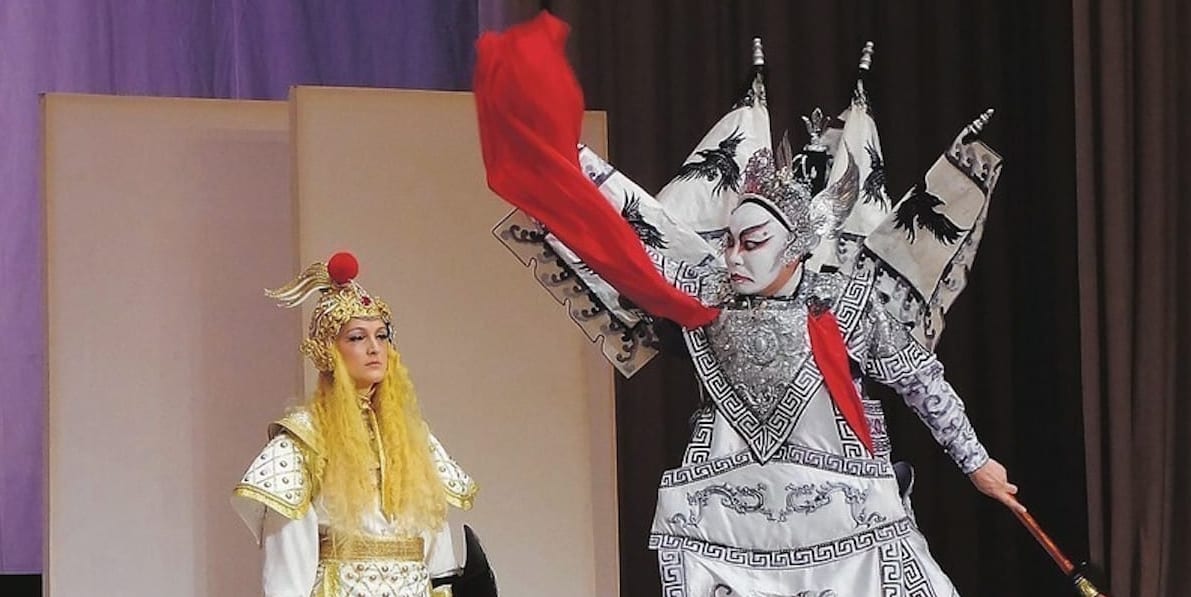Night falls at the waterfront of the river Spree. A stream of fog accompanies the overture of the Nibelung. As the incoming steam from left and right collides, the cultures from the Far East and West take us into a place of myths that endured all times, which is yet taken to a contemporary spectacle. Underneath the water’s surface, you will find a well-protected treasure that enables its possessor to become the mightiest one on earth. Only those who renounce love can own the power of the Rhine’s gold. But all human beings are looking for love. What about the gods? Or mythic creatures? What is more important to them, the power or the love?
The well-known fabrics of a long extant legend disenchant the male powers of our dear friends Wotan, Hagen, Gunther and Siegfried. Blinded by material values, they could not see their destined occupations as fathers, sovereigns and lovers. Driven by their own greed, the ring paves the path for their contribution to the destruction of the laws of their time. If love did not intervene, faith might have ended this story of cultural heritage earlier than expected: Erda wants to save Nature, Brünnhilde seeks to turn around her brother’s destiny because of love, Gutrune submits to her own needs and her brother’s attempts to get married. Unlike any other adaptations, this piece takes on a terrible testimonial to the narrow vision of all men by showing that women are capable of averting the evil and toxic desires of power, if only for a brief time.
Director Anna Peschke does not pursue in this production the assimilation of Western traditions or the classical representation of Wagner’s time travel through the Nibelung. Other than that, with help from Wang Huquan and Liu Dake, she transforms the myth into power-struggle that stands the test of time. The characteristics of the popular Beijing Opera entail everything it takes to represent the chronicles of heroes: the dynamic continuum of fight, dance and an everlasting power struggle. With the material of an ancient saga, the finest selection of musicians and players, the project has all the potential to subvert all the usual conventions of tales as old as time.
Aiming at power and simultaneously seeking for pleasure become the salient motifs to the circle of life’s purpose. Costumes and makeup creating expressive masquerades accomplish a piece of art. In that way, the ensemble produces a visual spectacle that makes it hard to blink. Emphasized, choreographed grace follows up on this unique vision through the stress on moves in a flowing response to the music. So very different from European theatre, the entry of every role deploys the atmosphere needed. Without distractions from other props, the cooperation of European and Chinese instruments create a set up as a whole; the mixture of dark tones from the gongs as well as high pitched glissando flutes build a sphere that opens up a Doppler shift that surrounds the rhythmical dialogues.
The intercultural work of “Der Ring des Nibelungen” works as a homage to 25 years of cooperation between the cities Berlin and Beijing. Unfortunately, the acoustics within the salon of the Radialsystem cannot sustain or help the musical theatre unfold its full melodic power and therefore it fails to spark emotional references. Whether the Elbphilharmonie in Hamburg can empower the musical interplay as a whole, remains to be seen in April. I can only hope that this avant-garde approach will thrive until then to fulfil its magical legacy that will meet the expectations of all the senses.
When the night is over, a new age is coming. Next time maybe not at the river Spree, but the Alster might work just as well.

